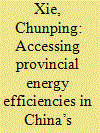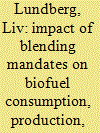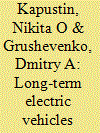|
|
|
Sort Order |
|
|
|
Items / Page
|
|
|
|
|
|
|
| Srl | Item |
| 1 |
ID:
162270


|
|
|
|
|
| Summary/Abstract |
The transport sector is attracting increasingly attention in the context of climate change and sustainable development, for its rapidly growing demand for energy and heavy reliance on oil products. Especially in China, where the demands for transportation are tremendous and ever-increasing, it is worthy to explore the provincial variations in energy efficiency in the transport sector, in order to enhance energy efficiency and to promote energy savings in this sector. By using stochastic frontier analysis (SFA) approach, this paper calculates the provincial energy efficiency as well as energy saving potential in China’s provincial transport sector over 2007–2016. Results suggest that China’s national average energy input efficiency in the transport industry is 0.673 during the sample period, which implied that relatively large degree of non-efficiency exists in this sector. Besides, the increase of government support (GS), the improvement of road condition (RC) and public transport (PT) are influencing factors for the improvement of China’s provincial energy efficiency in the transport industry. Additionally, energy saving potential in the transport sector is also estimated in this paper. It is shown that, although energy efficiency in the eastern China is the highest (much higher than the country-wide level), the estimated absolute amount of the energy saving potential in the eastern area is significantly larger than those in the central area and western area due to the fact that the eastern area contributes to the largest share of the total energy consumption in this sector.
|
|
|
|
|
|
|
|
|
|
|
|
|
|
|
|
| 2 |
ID:
111353


|
|
|
|
|
| Publication |
2012.
|
| Summary/Abstract |
This study has proposed a new solution concerning fuel consumption in China's transport sector, which has provided a more accurate basis for estimating CO2 emissions in the transport sector both on national and regional level. Our analysis indicated that CO2 emissions in China's transport sector in 2007 reached to 436 Mt, higher than 408 Mt estimated by IEA. The CO2 emissions in transport sector accounted for 7% of China's total fossil fuel combustion CO2 emissions, which is much lower than the global average level of 23%. The CO2 emission from road transportation was 376.6 Mt, 37% higher than IEA's estimation. Therefore we thought IEA significantly underestimated the amount of CO2 emissions from road transportation in China, inevitably they overestimated CO2 emissions in other transportation means. The IEA's result of road transportation CO2 emissions is only 67.64% in the entire transport sector, but our study showed this ratio could be up to 86.32%. This study also preliminarily analyzed the driving-forces of CO2 emissions in transport sector at regional level. The results showed that the CO2 emissions in transport sector are closely associated with GDP. Finally the article had reviewed some policies in China's transport sector.
|
|
|
|
|
|
|
|
|
|
|
|
|
|
|
|
| 3 |
ID:
091520


|
|
|
|
|
| Publication |
2009.
|
| Summary/Abstract |
This paper analyzes trends in the technological profile of the Austrian personnel vehicle fleet from 1990 to 2007. This includes the parameters of power, engine size and weight, which beyond the technological efficiency of the motor engine itself, are considered to be the main determinants of the fuel efficiency of the average car stock. Investigating the drivers of ever rising transport related greenhouse gas emissions is crucial in order to derive policies that strive towards more energy-efficient on-road passenger mobility. We focus on the efficacy of technological efficiency improvements in mitigating climate-relevant emissions from car use in light of shifting demand patterns towards bigger, heavier and more powerful cars. The analysis is descriptive in nature and based on a bottom-up database that was originally collated for the purpose of the present study. Technological data on car models, which includes tested fuel consumption, engine size, power and weight, is related to registered car stock and, in parts, to newly registered cars. From this, we obtain an original database of the Austrian passenger car fleet, i.e. information on consumer choice of specific car models, segregated by gasoline and diesel fuelled engines. Conclusions are derived for policies aimed at reducing the fossil fuel consumption of the moving vehicle fleet in order to contribute to a low carbon society.
|
|
|
|
|
|
|
|
|
|
|
|
|
|
|
|
| 4 |
ID:
183039


|
|
|
|
|
| Summary/Abstract |
Many countries have only recently introduced carbon taxation to reduce emissions and the time series data for evaluating these policies is not available yet. We use the introduction of fossil taxes in the German transportation sector to evaluate the effectiveness of environmental taxation. We employ synthetic control methods in the quantitative section of our analysis. The results indicate that the carbon price increase by about 66 €/t CO2 led to a considerable decline of transport emissions by 0.2–0.35 t per person and year. We also show that the sales share of diesel cars quickly increases after the reform, whereas the fuel efficiency of non-diesel cars increases with a three-year time lag. Most importantly, a qualitative analysis of a German car manufacturer's business reports also suggests that the tax triggered an improvement in engine technology.
|
|
|
|
|
|
|
|
|
|
|
|
|
|
|
|
| 5 |
ID:
192774


|
|
|
|
|
| Summary/Abstract |
The transport sector accounts for about 20% of EU's GHG-emissions. Progress in emission reductions has been slow and primarily driven by biofuels promoted through national blending mandates. The mandates differ in whether they are measured in volume, energy, or emission reduction and in how gasoline and diesel are targeted. Due to this, national mandates and their effects have not previously been quantitatively compared on an EU level. In this article we convert the mandates for all EU member states between 2009 and 2020 to a common unit and study their impact on biofuel consumption, production, emission reductions and fuel prices. We find that mandates are driving biofuel consumption in the EU and correlates with emission reductions. Increased mandates have however often been fulfilled by blending biofuels eligible for double counting. We also find that reduction mandates have been effective in encouraging high-performance biofuels. For historical fuel prices, we do not see a clear correlation between countries' shares of biofuel and consumer fuel prices while the global oil price has a considerable impact. For biofuel production, increased demand drive investments in the EU, but when it comes to localisation of new plants factors such as local infrastructure are more important than national mandates.
|
|
|
|
|
|
|
|
|
|
|
|
|
|
|
|
| 6 |
ID:
171436


|
|
|
|
|
| Summary/Abstract |
The last decade was marked by a new boom of popularity for electric transport. Massive government support helped increase EV annual sales from just 2 to over 753 thousands worldwide over the ten years. Many countries and private enterprises hold extremely high hopes for electric transport, predicting the imminent abandonment of the internal combustion engines (ICE). Our research shows that in 2018 EVs are yet still unable to compete on equal footing with conventional cars. However, should government and auto manufacturers maintain the current pace of development, true competitiveness between ICE and electric vehicles can be achieved by 2035 even in the low-oil-price environment.
Our calculations indicate that by 2040, depending on the scenario, the EVs can secure an 11–28% share of the global road transport fleet. This will lead to an additional increase in global electricity consumption of 11–20%. The challenge, however, is the adaptation of power grid to the growing demand peaks due to EVs charging patterns. To maintain the course on “green” energy, global leaders in EV adoption need to double the efforts on development and implementation of energy storage technologies, otherwise, the spread of electric cars will lead to more fossil fuel consumption.
|
|
|
|
|
|
|
|
|
|
|
|
|
|
|
|
| 7 |
ID:
126589


|
|
|
|
|
| Publication |
2013.
|
| Summary/Abstract |
With rapid economic growth, the transport sector plays an important role in China's CO2 emissions. The existing research is extensively concerned with transport sector CO2 emissions in recent years, but little attention has been paid to regional differences. This paper investigates CO2 emissions in the transport sector at the national and regional levels using the STIRPAT model and provincial panel data from 1995 to 2010 in China. The results showed that passenger transport dominates CO2 emissions in the transport sector, but its influence varies across regions. Electrification has significant potential to lower CO2 emissions because of resulting higher fuel efficiency and reduced pollution. Energy efficiency improvement is effective but limited in reducing emissions due to increasing demand from economic development and population growth. These results not only contribute to advancing the existing literature, but also merit particular attention from policy makers in China.
|
|
|
|
|
|
|
|
|
|
|
|
|
|
|
|
| 8 |
ID:
125715


|
|
|
|
|
| Publication |
2013.
|
| Summary/Abstract |
The rapid growth of urban population and the development of road infrastructures in Tunisian cities have brought about many environmental and economic problems, including the rise scored in energy consumption and the increase in the quantity of gas emissions arising from road transport. Despite the critical nature of such problems, no policies have yet been adopted to improve energy efficiency in the transport sector. This paper aims to determine driving factors of energy consumption change for the road mode. It uses decomposition analysis to discuss the effects of economic, demographic and urban factors on the evolution of transport energy consumption. The main result highlighted in the present work is that vehicle fuel intensity, vehicle intensity, GDP per capita, urbanized kilometers and national road network are found to be the main drivers of energy consumption change in the road transport sector during 1990-2006 period. Consequently, several strategies can be elaborated to reduce road transport energy. Economic, fiscal and regulatory instruments can be applied in order to make road transport more sustainable.
|
|
|
|
|
|
|
|
|
|
|
|
|
|
|
|
| 9 |
ID:
091535


|
|
|
|
|
| Publication |
2009.
|
| Summary/Abstract |
This paper examines the effects of replacing current fuel taxes by a system of taxes that account better for all the different external costs of the different transport modes. One of the important implications of this reform is that current fuel taxes are decreased to a level of 80 euro/ton of CO2 but that the mileage related taxes on car and truck use increase. Using the TREMOVE model for the transport sector of 31 European countries, one finds that the volume of transport will decrease because current taxes on transport are too low compared to overall external costs. Overall CO2 emissions will decrease slightly. Using the MARKAL-TIMES model for the Belgian energy sector, putting all sectors and technologies on equal footing shows that a fuel tax reform makes that it is not cost efficient to require large CO2 emission reductions in the transport sector and that traditional car technologies will continue to dominate the car market in 2020-2030.
|
|
|
|
|
|
|
|
|
|
|
|
|
|
|
|
|
|
|
|
|